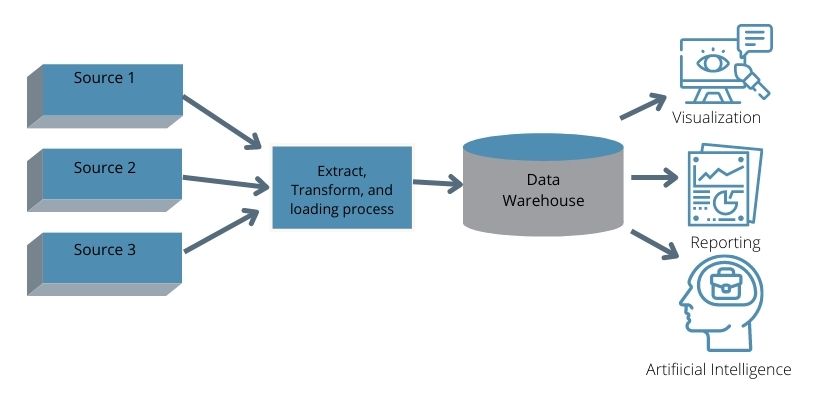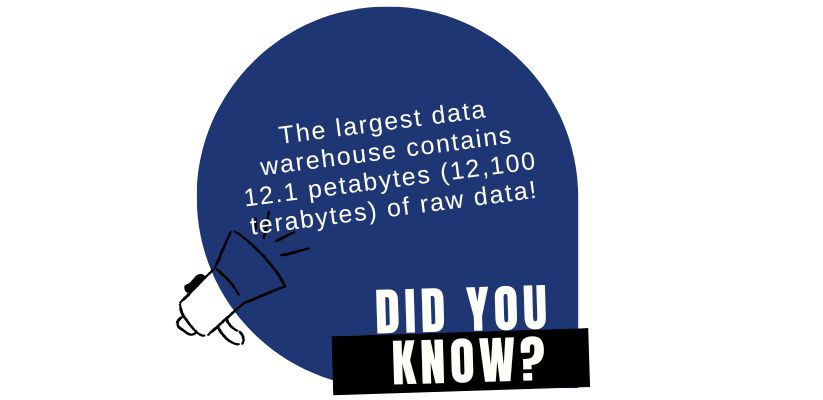Summary: Data warehouses include vast amounts of past data specifically intended to resolve queries and analyze data. This blog post will let us learn what a data warehouse is and components of data warehouse.

What is a data warehouse?
The data warehouse is a data management type specifically crafted to stimulate business intelligence operations, reporting, and analytics. It also supports other regulatory requirements so that organizations can convert their data into valuable insights that lead to entire data-driven decisions. A data warehouse saves current as well as past data in one place while acting as a single source of truth for a business.
In business operations, data continuously flows from various operating systems like ERP and CRM, external resources, IoT devices, and more. However, in the past few years, data storage places have been hugely transformed into multiple locations, including the public, on-premise, and private cloud. Learn about significant components of data warehouse.
Significant Components of Data Warehouse
As per the data warehouse architecture, a data warehouse has four components- ETL tools (Extract, Transform, Load), central database, access tools, and metadata. These components of data warehouse are specifically designed for enhanced speed so you can get the results faster and flawlessly analyze data on the go.
Let us now see the components of the data warehouse in detail.
1. Warehouse database
Warehouse database is the first one among the components of data warehouse.
Central database-
It keeps all business data in the data warehouse while making it easier to report. There are various database types in which you can store the specific data types in the warehouse. These database types include-
Analytics database-
These databases help manage and sustain analytics of data storage.
Cloud-based database-
Here, the databases can be retrieved and hosted on the cloud so that you do not have to acquire hardware to set up a data warehouse.
Typical rational databases-
These are row databases used on a routine basis.
2. ETL (Extraction, Transformation, Loading) Tools
ETL tools are the central components of data warehouse and help extract data from various resources. This data is then transformed into a suitable arrangement and is later loaded into the data warehouse. They allow you to extract data, fill mislaid data, highlight data distribution from the central repository to BI applications, and more.
Simply put, data is pulled from resources and altered to align the data for fast analytical consumption. It is carried out by a variety of data integration strategies, including ETL, ELT, bulk-load processing, real-time data duplication, data quality, data transformation, and more.
3. Metadata
Metadata is termed as ‘data about your data.’ It is one of the major components of data warehouse. Metadata tells you everything about the usage, values, source, and other features of the data sets in the warehouse. Additionally, business metadata includes a context to the technical data as well. It describes the method to access the data, where it resides, and how well it is structured. Metadata is also classified as business meta-data having information which gives users a simple understanding of the information warehouse.
Metadata offers interactive and easy access to the users, which helps them understand the matter and find get the data. Its management is carried out through the repository and other accompanying software. The software relies on a workstation and easily maps the source to the target database. Also, it creates code and controls the operational data to the respective warehouse.
Since data warehouse is a project, you need a flexible approach to implement it as effectively as possible. This is where effective warehouse architecture comes into the scene.
4. Access Tools
Data warehouses make use of a group of databases as the primary base. However, data warehouse organizations can’t work with databases without using the access tools until a database administrator is available. But, to cope with the changing conditions, it becomes necessary to use data warehouse tools as the major components of data warehouse, including data mining tools, app development tools, OLAP tools, query/reporting tools, and more.
Data mining tools-
They streamline the process of checking arrays and links in vast volumes of data with the use of statistical modeling methods.
OLAP tools-
These tools aid in building a multi-dimensional data warehouse while allowing business data analysis from various points.
Application Development tools-
They help develop customized reports.
Query reporting tools-
With these tools, corporate report production is quickly done through spreadsheets, innovative visuals, and spreadsheets as well.
5. Reporting layer
The reporting layer in a data warehouse helps customers to get access to BI database architecture and interface. Its prime aim is to be a dashboard to bring data visualization, fetch needed information, and create reports.
The query and reporting tools include-
Dashboard tools-
These software applications display complex business information and metrics, allowing quick understanding.
Data mining tools-
They enable customers to implement in-detail statistical and numerical calculations that identify designs and analyze trends along with data.
6. Additional components
There exist some additional components of data warehouse in a few data warehouses. They are-
- Logical data marts-
It is an altered view of the significant data warehouse. But, logical data marts do not exist physically as an independent data element. - Operational data store-
It is an integrated database of operational data while its sources contain legacy systems. It also includes near and current term information. - Dependent data marts-
It is a physical database that fetches all the information from the data warehouse.
7. Data warehouse bus
It is among the main components of data warehouse. The warehouse bus indicates the flow of data in a data warehousing bus system and has a data mart. It is a level that helps users transmit data and is also used to partition data produced for a specific group.
Benefits of a Data Warehouse
A precisely designed data warehouse is quintessential to carrying forward a successful analytics program. The primary functions of a data warehouse include dashboards, analytical tools, and reports that are quintessential for organizations. It offers appropriate data-driven decisions while assisting you in making the right decision on developing a new product and inventory. An adequately properly designed components of data warehouse helps execute queries too quickly. It offers higher advantages over on-premises and traditional versions.
Let us now see some benefits of a data warehouse:
- Advanced business analytics- With DW, decisions can be made easily while also allowing access to data from different resources and removing the redundancy of making decisions on inappropriate data.
- Integration- DWs develop consistency through various data types and integrate them well.
- High data quality- Data cleansing cases are developed by the entire system and are stored in the worklist for the following processing.
- Quick queries- The primary purpose of data warehouses is explicitly developed for data analysis and retrieval. You can quickly draw vast amounts of data with very little support from the IT department.








